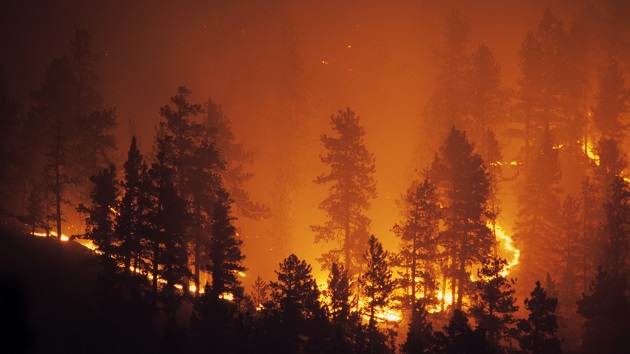
milehightraveler/iStock
milehightraveler/iStockBy JULIA JACOBO, ABC News
(SAN FRANCICSO) — Drought conditions in the West are so severe that officials are worried about the potential of a fire season even more dangerous than the last.
In Colorado, higher temperatures and lower precipitation after a winter with less-than-normal snowfall has made the land similar to a tinderbox should a flame spark a wildfire, officials from the Colorado Division of Fire Prevention and Control told reporters in a press conference Thursday.
“Historically, wildfire seasons were a four-month event in the middle of summer. Today, the average core wildfire season is 78 days longer than in the 1970’s, with Colorado experiencing large fires every month of the year.” – @COStateFire Director Mike Morgan #cofire pic.twitter.com/HMvBN05YDq
— COFirePrev&Control (@COStateFire) April 8, 2021
Top-ranking firefighters in the state said during the wildfire outlook presentation that the current weather conditions will not allow them to start mitigation efforts they would typically be doing at this time of year, such as controlled burns that stand between areas of concern and populated towns.
In Southern California, the latest drought monitor on Thursday showed worsening conditions, putting Los Angeles County under the “Severe Drought” category ahead of the dry season.
A cattle rancher in Petaluma, California, about 40 miles north of San Francisco, reported that the reservoir pond on his property, which typically collects rainwater runoff, is completely dry due to the lack of precipitation.
“That pond should be running over right now,” Don DeBernardi told ABC San Francisco station KGO.
When asked whether the pond has ever been empty, DeBernardi, who has owned the property since 1976, replied “Never. Never. Never,” adding that the current drought has been “probably the worst one.”
When filled, the pond has enough water to run DeBernardi’s ranch and give his hundreds of cows water for a year and a half, he said. But the bottom is so dry that the bottom has begun to crack.
At the beginning of March, 46.6% of the contiguous U.S. was in drought, according to the U.S. Drought Monitor Report. Drought conditions have especially intensified and expanded across portions of the Northeast, Texas, the northern Plains and California, according to the report.
Both California and Colorado had historic fire seasons in 2020.
Colorado had four of its largest wildfires in state history last year, officials said. Some believe that if it were not for an unusual snowstorm that hit at the right time, the towns of Estes Park and Grand Lake may have been destroyed by the deadly East Troublesome Fire, which spread through 87,093 acres in late October.
People sit on a dried lake bed at the San Luis Reservoir in Merced County, Calif., April 6, 2021.
In California, more than 4 million acres burned in 2020 after dozens of wildfires, some major, burned simultaneously through the state through September.
Three of the top five fires in California state history occurred in 2020. Firefighters in the state have not seen anything like that season in more than 100 years, when the Great Fire of 1910 blazed through more than 3 million acres.
While conditions of the landscape in the West make wildfires a natural occurrence, fire seasons have intensified as a result of warming global temperatures, climate scientists have told ABC News.
The amount of forest area burned by wildfires between 1984 and 2015 was twice what would have burned had climate change not occurred, according to the 2018 U.S. National Climate Assessment.
The Colorado state government is pouring resources into preparation for wildfires to buy more helicopters, airplanes and drones and hire more firefighters, Gov. Jared Polis said at the press conference Thursday, while California Gov. Gavin Newsom announced that $536 million will be dedicated toward wildfire mitigation and forest management projects ahead of fire season.
ABC News’ Jeffrey Cook, Max Golembo and Jennifer Watts contributed to this report.
Copyright © 2021, ABC Audio. All rights reserved.